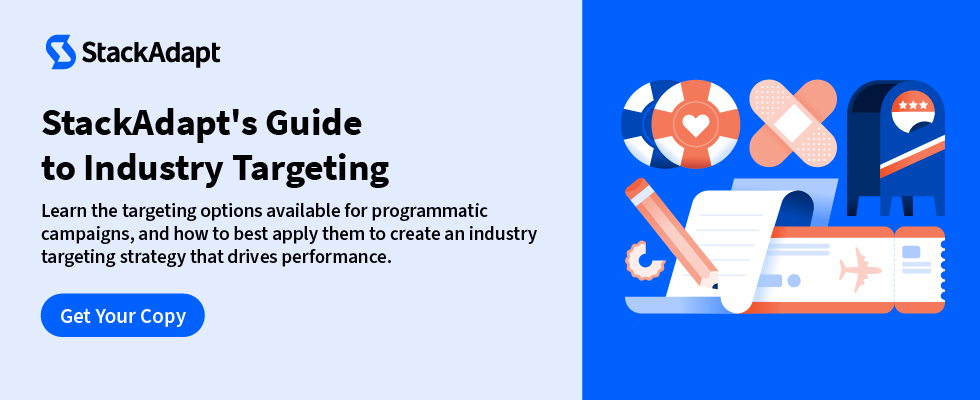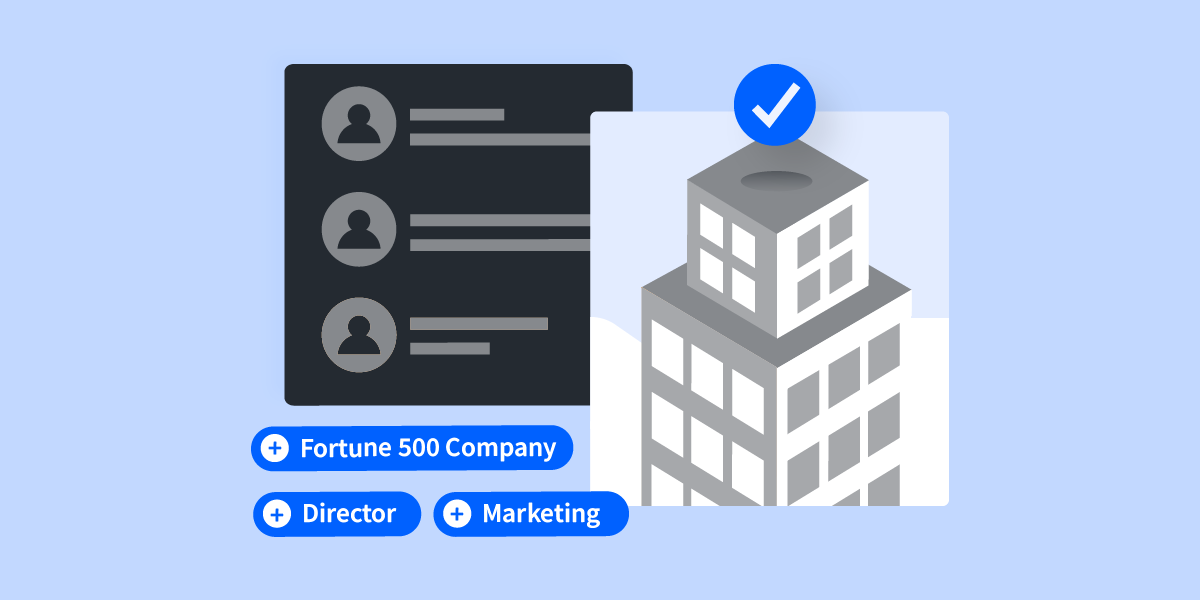When it comes to programmatic advertising, capturing and targeting the most relevant audience is a key component to any campaign. Finding the ideal target market for your product can be particularly difficult when consumers fall into various demographic or behavioural buckets.
If everyone falls into multiple categories, how do you know where to find the right people, for the right product, at the right time? One solution is to leverage industry targeting.
What is Industry Targeting
In the world of digital advertising, industry targeting is a strategy that enables you to segment your audience into groups, based on specific industries.
Industry targeting involves taking a step back to look at your audience and determine if they fit into specific topical groups, based on interest, industry, or marketing vertical. This could include categories such as travel, retail, finance or healthcare.
With industry targeting you can leverage programmatic ads to capture a focused, intent-driven audience. You can use specific messaging tailored for that segment and curate the content to cater to the unique needs and interests of your target market.
Industry targeting strategies can be especially helpful for advertisers who market toward different industries. For example, B2B brands often need to find industry specific research and develop unique personas for various segments.
A B2B brand that sells office furniture might explore ways that they can position their brand and products for specific industries. The way this type of brand advertises to a financial services company will be different from their messaging for a doctor’s office.
Other brands may have industry specific solutions they’re trying to sell. Or, they may be tweaking the positioning of the same solution or product to appeal to audiences across different industries. In all these scenarios, an industry targeting strategy will be beneficial.
How to Get Started With Industry-Focused Campaigns
To help get you started with industry targeting, we’ve put together a 4-step guide to building your industry targeting strategy for programmatic.
1. Reconfirm Your Target Market
You likely know your target markets based on past purchasing behaviour or the success of your previous campaigns. However, you might be overlooking a few, or targeting an audience that is very broad.
Dig deeper into your customer data to confirm your top verticals and perhaps uncover a few sub-verticals as well. Think about what interests or characteristics your customers share or pick features from your offering that you believe are appealing, either from reviews or direct feedback, and consider who else might enjoy or benefit from them.
It is best to rely on defined metrics or data points where you can. For example, identify the characteristics of your top spenders to draw conclusions about who your target market is.
2. Build Your Buyer Personas
Next, you’ll want to crystallize who your ideal customer is in the industry you want to target, and start to consider the audience insight you’ll need to gather in order to reach them effectively. This is a crucial step in building a successful industry targeting strategy.
Building a buyer persona is essentially creating a profile of a person who represents the exact centre of your target market. This ideal (fictional) customer is given a name, age, even a profile picture, and made into a “real” person by leveraging data that you collect. Having a data-informed view of your target audience makes it easier for creative and media teams to identify with, and create ads for these users.
To build your personas, you’ll first want to leverage your 1st-party data. This primary data reveals important information on existing audience behaviours, traits, preferences, buying habits, and interests which can inform your personas. This data may also tell you something you didn’t know about your current customers.
For example, if you find that customers in a specific vertical are typically buying multiple products together at once, you may consider this when targeting lookalike audiences in your media strategy.
Primary data sources include your CRM, sales data and website analytics just to name a few. You could also conduct customer interviews, or hold internal stakeholder interviews. Employees in positions such as sales or customer service are often a wealth of knowledge when it comes to audience insight.
You’ll then want to review secondary research to supplement what you’ve learned from 1st-party data insights. Research tools like eMarketer, Netbase, Environics, Comscore, and Forrester are a good starting point.
When gathering data to build buyer personas, there are a few categories of insights that you’ll want to be sure you explore:
- Demographics (age, gender, income, marital status, job title, etc.).
- Psychographics (major life events, life challenges, accomplishments, etc.).
- Behaviour and preferences (social networks they use, devices they own, hobbies, etc.).
- Buyer’s journey (what product needs they have, key channels and touchpoints, concern for price vs quality, etc.).

Personas should be built using data, not hunches. If you try to answer these questions without using reliable data and sources, you might be overlooking some integral points of view that you hadn’t thought of previously.
3. Map Your Customer’s Buying Journey
Now that you have buyer personas, you can map their individual paths to purchase to determine where your ads will be most effective. Consider the entire research process for a potential customer, along with the purchasing stages, and all of the ways they might be using channels and devices throughout. This is called “journey mapping.”
For example, for a potential retail shopper, don’t assume they only use a desktop to research products. You might end up overlooking their mobile activity, which may be integral to the buying process. Once you have mapped out the customer’s buying journey, you can identify the best time to capture their attention with an ad, ultimately increasing the probability that your industry targeting strategy will result in conversions.

Journey mapping is about reaching the right audience, on the right channel or device, at the right moment, and with the right message. A strong journey map will help in personalizing your digital marketing strategy, so that the journey, and ultimately messaging, resonates with your ideal audience.
4. Leverage Your Programmatic Platform
You will want to use advertising technology with the appropriate targeting parameters to support your industry targeting strategy. This includes partnering with a programmatic platform that offers the channels and features you need to reach the right audience.
You’ll want to find a programmatic partner that supports custom, intent-based segments that capture people who are actively reading about topics relevant to your brand or your competition.
It’s also recommended to ensure your programmatic platform offers various channels, like connected TV, programmatic audio, and in-game advertising. This way, you’re able to reach your audience through a multi-channel campaign that meets them where they are: which is across various online channels and devices.
Get Started With Industry Targeting
Each industry offers unique opportunities to build out your campaigns, and there are different tools and tactics you can leverage for each. With industry targeting, you can personalize your digital marketing. This enables you to cater your campaigns to give your audience exactly what they are looking for, and at the moment they’re looking for it.
Check out each of the industries we have taken a deep dive into, and how to tackle the campaign planning for each:

Want to run industry-focused programmatic campaigns? Request a demo to learn more about StackAdapt.





